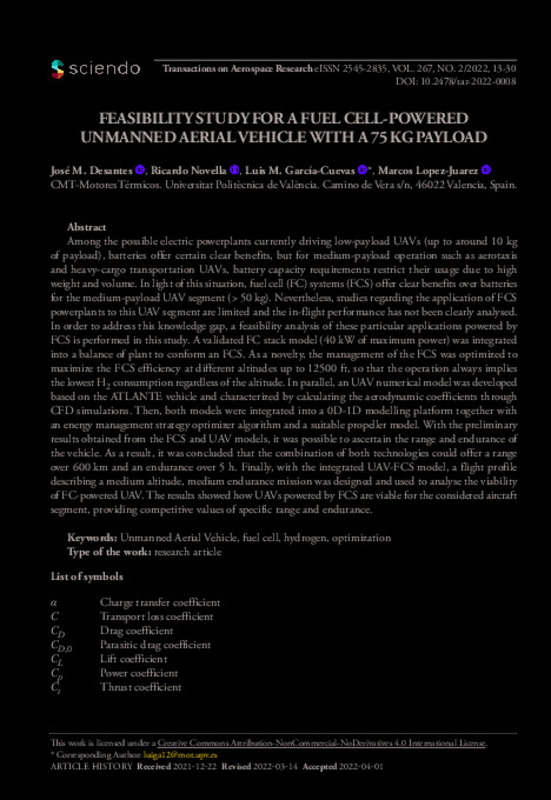[1] European Commission, 2019, “A European Green Deal: Striving to be the first climate-neutral continent”, URL https://ec.europa.eu/info/strategy/priorities-2019-2024/european-green-deal_en.
[2] European Commission, “European Partnership for Clean Aviation”, URL https://ec.europa.eu/info/law/better-regulation/have-your-say/initiatives/11904-European-Partnership-for-Clean-Aviation_en.
[3] Chiaramonti, D. “Sustainable Aviation Fuels: the challenge of decarbonization.” Energy Procedia Vol. 158 (2019). pp. 1202–1207 DOI 10.1016/j.egypro.2019.01.308. Innovative Solutions for Energy Transitions.
[+]
[1] European Commission, 2019, “A European Green Deal: Striving to be the first climate-neutral continent”, URL https://ec.europa.eu/info/strategy/priorities-2019-2024/european-green-deal_en.
[2] European Commission, “European Partnership for Clean Aviation”, URL https://ec.europa.eu/info/law/better-regulation/have-your-say/initiatives/11904-European-Partnership-for-Clean-Aviation_en.
[3] Chiaramonti, D. “Sustainable Aviation Fuels: the challenge of decarbonization.” Energy Procedia Vol. 158 (2019). pp. 1202–1207 DOI 10.1016/j.egypro.2019.01.308. Innovative Solutions for Energy Transitions.
[4] Lee, S., Kim, G. and Bae, C. “Effect of injection and ignition timing on a hydrogen-lean stratified charge combustion engine.” International Journal of Engine Research. 0nlineFirst (2021). DOI 10.1177/14680874211034682.
[5] Caton, P.A. and Pruitt, J.T. “Homogeneous charge compression ignition of hydrogen in a single-cylinder diesel engine.” International Journal of Engine Research Vol. 10 No. 1. (2009). pp. 45–63. DOI 10.1243/14680874Jer02208.
[6] Christo, F.C., Levy, Y., Costa, M. and Balelang, G.A. “Effect of jet momentum flux and heat density on NOx emission in a flameless gas turbine combustor.” Aerospace Science and Technology Vol. 119 (2021). p. 107137. DOI 10.1016/j.ast.2021.107137.
[7] Baroutaji, A., Wilberforce, T., Ramadan, M. and Olabi, A.G. “Comprehensive investigation on hydrogen and fuel cell technology in the aviation and aerospace sectors.” Renewable and Sustainable Energy Reviews Vol. 106 (2019). pp. 31–40. DOI 10.1016/j.rser.2019.02.022.
[8] Molina, S., Novella, R., Pla, B. and Lopez-Juarez, M. “Optimization and sizing of a fuel cell range extender vehicle for passenger car applications in driving cycle conditions.” Applied Energy Vol. 285 (2021) p. 116469. DOI 10.1016/j.apenergy.2021.116469.
[9] Desantes, J.M., Novella, R., Pla, B. and Lopez-Juarez, M. “Impact of fuel cell range extender powertrain design on greenhouse gases and NOx emissions in automotive applications.” Applied Energy Vol. 302 (2021). p. 117526. DOI 10.1016/j.apenergy.2021.117526.
[10] Terada, I. and Nakagawa, H. “Polymer electrolyte Fuel Cell.” Kobunshi Vol. 57 No. 7 (2008). pp. 498–501. DOI 10.1295/kobunshi.57.498.
[11] Murschenhofer, D., Kuzdas, D., Braun, S. and Jakubek, S., “A real-time capable quasi-2D proton exchange membrane fuel cell model.” Energy Conversion and Management, Vol. 162 (2018). pp. 159-175. DOI 10.1016/j.enconman.2018.02.028.
[12] Corbo, P., Migliardini, F. and Veneri, O. “Experimental analysis of a 20 kWe PEM fuel cell system in dynamic conditions representative of automotive applications.” Energy Conversion and Management Vol. 49 No. 10 (2008). pp. 2688–2697. DOI 10.1016/j.enconman.2008.04.001.
[13] Corbo, P., Migliardini, F. and Veneri, O. “Experimental analysis and management issues of a hydrogen fuel cell system for stationary and mobile application.” Energy Conversion and Management Vol. 48 No. 8 (2007). pp. 2365–2374. DOI 10.1016/j.enconman.2007.03.009.
[14] Teng, T., Zhang, X., Dong, H. and Xue, Q. “A comprehensive review of energy management optimization strategies for fuel cell passenger vehicle.” International Journal of Hydrogen Energy Vol. 45 No. 39 (2020). pp. 20293–20303. DOI 10.1016/j.ijhydene.2019.12.202.
[15] Burress, T.A., Campbell, S.L., Coomer, C.L., Ayers, C.W., Wereszczak, A.A., Cunningham, J.P., Marlino, L.D, Seiber, L.E. and Lin, H., “Evaluation of the 2010 Toyota Prius Hybrid Synergy Drive System.”, Oak Ridge National Laboratory, Tennessee, USA. (2011).10.2172/1007833
[16] Airbus Defence & Space. “Atlante: Tactical fixed wing multirole UAS for maximized operational capability and mission flexibility.” (2014) URL https://www.airbus.com/content/dam/products-and-solutions/unmanned-air-systems/atlante/atlante-brochure.pdf.
[17] Cassidian. “Atlante: Tactical Unmanned Aerial System for National Security.” (2014) URL https://www.airtn.eu/downloads/atlante-para-airtn_v2.pdf.
[18] Rivard, E., Trudeau, M. and Zaghib, K. “Hydrogen storage for mobility: A review.” Materials Vol. 12 No. 12 (2019). DOI 10.3390/ma12121973.663099131248099
[19] U.S. Department Of Energy. “DOE Technical Targets for Fuel Cell Systems and Stacks for Transportation Applications.” (2015). URL https://www.energy.gov/eere/fuelcells/doe-technical-targets-fuel-cell-systems-and-stacks-transportation-applications.
[20] Howell, D., Cunningham, B., Duong, T. and Faguy, P. “Overview of the DOE VTO Advanced Battery R&D Program.” U.S. Department Of energy (2016).
[-]









